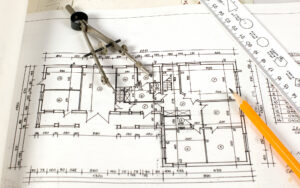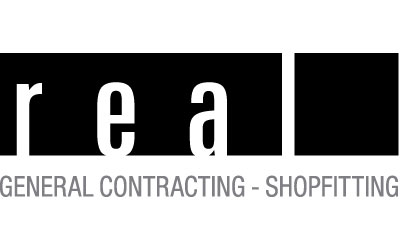The execution planning is the first detailed representation of a project. Detailed descriptions and, above all, detailed drawings and plans are created. Thus, the first basis for a successful construction is set. The most exact representation possible stands in the process for service phase 5 of the HOAI (Architects’ Ordinance). The implementation planning serves as orientation for the practical implementation on the construction site.
Implementation planning stage one: the design plan
The design plan is the first stage of implementation planning and already represents a drawing of the floor plans and building sections that is as detailed as possible. Design plans usually include the planning of building services, fire protection concepts or static planning. In addition, comments are already made on how the implementation can ultimately be carried out operationally at the construction site. The scales can vary depending on the level of detail of the drawing. From M 1:1 to 1:20 for more detailed sections to M 1:50 for model-like plan sections, various dimensions are used here.
Detailed design stage two: Work planning / detailed design
I n contrast to the design planning, the work planning or detailed planning is characterized by a detailed textual description and comprehensive information on the available drawings. Such work plans supplement the previously prepared, rather simplified plans and are thus of central importance for the individual construction steps. More precisely, the contents here concern the foundation, the entire floor superstructures, connections of roof, balconies, terraces and the like, right up to penetration points for electricity, gas or water. The plans here are also more detailed than the design plans. Scales of M 1:20 are now no longer exceeded here. The results of the work planning, also known as service phase 5, form the basis for the bill of quantities and thus for the preparation of the offer.
n contrast to the design planning, the work planning or detailed planning is characterized by a detailed textual description and comprehensive information on the available drawings. Such work plans supplement the previously prepared, rather simplified plans and are thus of central importance for the individual construction steps. More precisely, the contents here concern the foundation, the entire floor superstructures, connections of roof, balconies, terraces and the like, right up to penetration points for electricity, gas or water. The plans here are also more detailed than the design plans. Scales of M 1:20 are now no longer exceeded here. The results of the work planning, also known as service phase 5, form the basis for the bill of quantities and thus for the preparation of the offer.
Fee claims from service phase 5
From the work up to performance phase 5, the work planning, the architect has a lot to plan. For this reason, the architect is already entitled to fees. The architect and the client can agree on a settlement according to the Fee Structure for Architectural Services (HOAI). How high these are, however, varies depending on the construction measures. The extent depends on the construction costs, the degree of difficulty of the building (divided into five fee zones) and the services already rendered in phases 1-9. This means that the more complicated a building is and the more services an architect performs on it, the higher his fee claims will be. Service phase 5 accounts for around 25% of the total fee.
When does implementation planning end?
However, implementation planning is not finished for the architect with the start of the construction phase. Quite the opposite: the architect is even obliged to update the implementation planning. This is due to the fact that changes and adjustments have to be made constantly even during the construction phase. Ultimately, this must also be recorded in the execution planning and thus leads to a constant adjustment. As long as the planning goals themselves remain unchanged, no separate payment for this service is necessary. However, if the objectives are changed, the planning service must be remunerated repeatedly. This obligation to update the implementation planning applies to the architect until the end of the construction phase. Once this has been achieved, there is no longer any need to prepare an execution drawing. However, if a plan for the final state of the structure is desired, this must be commissioned separately.
Defect handling
D efects are usually not discovered until the construction phase. If the contract has already been awarded by then, the planners have little or no time to correct the defect. By observing a complete performance certificate and following all legal regulations, such defects can be remedied at an early stage. A comprehensive understanding of the VOB/A and VOB/C as well as the DIN standards applicable in the respective country will enable errors to be specifically identified and avoided. If the planner consistently follows these specifications and rules during service phase 5, no defects should occur until then.
efects are usually not discovered until the construction phase. If the contract has already been awarded by then, the planners have little or no time to correct the defect. By observing a complete performance certificate and following all legal regulations, such defects can be remedied at an early stage. A comprehensive understanding of the VOB/A and VOB/C as well as the DIN standards applicable in the respective country will enable errors to be specifically identified and avoided. If the planner consistently follows these specifications and rules during service phase 5, no defects should occur until then.
Liability for defects
If a defect is actually attributable to the planner, the building owners are not left sitting on their costs, but can then hold the planner accountable. If important details were omitted in the planning process or regulations were disregarded, the planner is guilty in the sense of a lack of planning. The architect responsible is also liable if the planning is not completed on time. However, the client can also be held liable in the event of defects. If there are already obvious errors in the contract planning, the architect is only partially liable. The rest of the blame lies with the client if he should have recognized the defect.
To avoid this, all planning aspects, no matter how small, should be included. Even if details seem self-evident, safety takes precedence in this point.
Effects of execution planning on the construction project
The execution planning should enable the craftsmen on the construction site to start the construction project immediately without delay. Care should be taken to ensure that both the floor plan drawings at a scale of 1:50 and detailed drawings at the usual scales of 1:20, 1:5 or 1:1 are handed over. It is recommended that the detailed design be included in the contract. Only on the basis of this is it possible to plan costs accurately. If this is not the case, additional costs can definitely be expected during the construction phase.
C hecklist for execution planning
hecklist for execution planning
- Are the details on the plans correct and complete? (Client, planner, location, date…)
- Are details and dimensions entered in continuous sizes and in the correct locations? (House dimensions, wall thicknesses, cracks…)
- Are opening dimensions of windows and doors entered in the correct locations?
- Are all connections and manholes entered?
- Are all supplementary plans available?
- Are the plans correctly numbered and can the plan numbers be clearly assigned?
Subsequent assembly planning
Subsequent assembly planning ensures that the previously defined construction specifications are implemented in the execution planning. The aim of the assembly planning is to ensure a smooth process on the construction site by means of defined work sequences, type and scope of the construction site equipment as well as the necessary personnel requirements. Only clearly assigned tasks and responsibilities make this possible. An important part of any assembly planning is a risk assessment. As a basis for assessing occupational safety, hazards, protective measures and compliance with them must be evaluated and monitored by the contractor. In order to take all hazards into account, all activities at the workplace must be considered. This documentation not only serves as legal protection, but can also help with the instruction of employees. Installation planning must be available at the construction site, unless all important information arising from it can already be obtained from the other plans and documents prepared.
Execution planning and what belongs to it
To proceed exactly according to HOAI or not?
Dynamic implementation planning: a trade-off
Implementation planning – the legal situation
From the basic determination to the preliminary, draft and approval planning to the preparation via duties to cooperate to the object supervision and support. The legal details are neatly summarized on the website Gesetze im Internet.
Empirical texts and texts prepared from journalistic sources such as this one do not constitute legal advice. For all legal issues, we advise you to seek the assistance of a specialist lawyer. Without judgement, you can find relevant experts for your questions here: specialist lawyers for construction law.
Image copyright: diego_cervo; carenas1; lightsource; 4zeva





